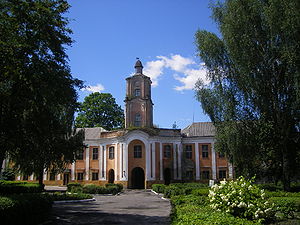- Olyka Castle
-
The Olyka Castle was the principal seat of the Radziwill princely family in Volhynia from 1564 until the late 18th century. The founder of the castle was Prince Mikołaj "the Black" Radziwiłł (1515–1565) who gave Olyka to his youngest son Stanisław. Two senior branches of the Radziwill family were based in Nesvizh and Kletsk.
The Olyka Castle was immensely influential as the first square fort with corner bastions in the Kresy and the prototype of many similar structures found in Eastern Europe. It was almost continuously under construction for eight decades and sustained numerous sieges between 1591 and 1648.
During Napoleon's invasion of Russia a Russian military hospital moved in and continued in use until 1837. A 1840 document refers to the castle as untenanted. In 1883, a campaign of restoration was launched but it was not taken to its conclusion until after the First World War.
The Olyka Castle comprises four residential buildings of unequal height, forming a court in the middle and encircled by a moat. The towers of the original castle have crumbled to the ground, but the network of bastions is still in place. The main palace of three storeys, although originally built in the 16th century, is essentially the upshot of renovations carried out in the 17th and 18th centuries.
Other buildings of the castle complex include a 17th-century gateway, a two-storey clock tower, and the Collegiate Church of the Holy Trinity (1635–1640), an elaborate replica of Il Gesu.
References
- Памятники градостроительства и архитектуры Украинской ССР. В 4-х томах. Гл. редкол.: Н. Л. Жариков. -К.: Будiвельник, 1983—1986. Том 2, с. 79-82.
Polish-Lithuanian Castles and Forts in the Kresy  Black RutheniaSurviving
Black RutheniaSurvivingOld Grodno • New Grodno • Lida • Mir • Nieśwież • Dwór Stanisławów RuinedGieraniony • Holszany • Krewo • Lubcz • Nowogródek • Różana  Volynia
Volynia GaliciaSurvivingRuined
GaliciaSurvivingRuined PodoliaSurviving
PodoliaSurvivingKamieniec Podolski • Latyczów • Międzybuż • Satanów RuinedBusza • Czarnokozińce • Kudryńce • Okopy Świętej Trójcy • Sidorów • Zinków • Żwaniec Categories:- Castles in Ukraine
- Volyn Oblast
- 1564 establishments
- Radziwiłł family
Wikimedia Foundation. 2010.

